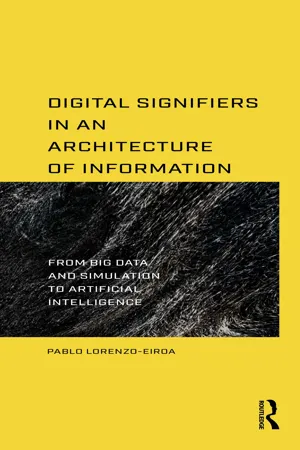
Digital Signifiers in an Architecture of Information
From Big Data and Simulation to Artificial Intelligence
- 472 pages
- English
- ePUB (mobile friendly)
- Available on iOS & Android
Digital Signifiers in an Architecture of Information
From Big Data and Simulation to Artificial Intelligence
About this book
This book proposes a new critical relationship between computation and architecture, developing a history and theory of representation in architecture to understand and unleash potential means to open up creativity in the field.
Historically, architecture has led to spatial representation. Today, computation has established new representational paradigms that can be compared to spatial representations, such as the revolution of perspective in the Renaissance. Architects now use software, robotics, and fabrication tools with very little understanding and participation in how these tools influence, revolutionize, and determine both architecture and its construction today. Why does the discipline of architecture not have a higher degree of authorship in the conception and development of computational technologies that define spatial representation? This book critically explores the relationship between history, theory, and cultural criticism. Lorenzo-Eiroa positions new understandings through parallel historical sections and theories of many revolutionary representational architecture canons displaced by conventional spatial projection. He identifies the architects, artists, mathematicians, and philosophers that were able to revolutionize their disciplines through the development of new technologies, new systems of representation, and new lenses to understand reality. This book frames the discussion by addressing new means to understand and expand architecture authorship in relation to the survey, information, representation, higher dimensional space, Big Data, and Artificial Intelligence – in the pursuit of activating an architecture of information.
This will be important reading for upper-level students and researchers of architecture and architectural theory, especially those with a keen interest in computational design and robotic fabrication.
Frequently asked questions
- Essential is ideal for learners and professionals who enjoy exploring a wide range of subjects. Access the Essential Library with 800,000+ trusted titles and best-sellers across business, personal growth, and the humanities. Includes unlimited reading time and Standard Read Aloud voice.
- Complete: Perfect for advanced learners and researchers needing full, unrestricted access. Unlock 1.4M+ books across hundreds of subjects, including academic and specialized titles. The Complete Plan also includes advanced features like Premium Read Aloud and Research Assistant.
Please note we cannot support devices running on iOS 13 and Android 7 or earlier. Learn more about using the app.
Information
Table of contents
- Cover
- Half Title
- Endorsements Page
- Title Page
- Copyright Page
- Dedication
- Table of Contents
- Preface
- Acknowledgments
- Introduction: Toward a Critical Multidimensional Artificial Intelligence: Displacing Bias in Data, Reference, Digital Signifiers, and Systems of Representation
- 1 Systems of Measurement Idealizing and Displacing Human Proportions
- 2 Brunelleschi’s Parametric Analog Computational Interface: From a New Media Normalizing Visualization to Indexing, Displacing, and Innovating in Representation
- 3 Palladio’s Parametric Undecidability as a Critical Topological Model
- 4 Borromini’s Topological Model Displaced by Rainaldi’s Ahistorical Synthesis: Architects Indexing, Displacing, and Innovating in Spatial Representation
- 5 Linguistic and Visual Semiotics signs as Signifiers Anticipating Authorship in Architecture
- 6 Computational Linguistic Semiotics: From Mathematics, to Computational Languages Grammar, to Machine Learning, to Signifieds in Natural Language Processing (NLP), to Emergent Programming
- 7 Computational Visual Semiotics: Grammatology Displacing Signals, Signs and Digital Signifiers From Pixels to Point Clouds and Particles Activating Emergent Programming
- 8 Displacing Origination by Digital Signifiers from Computation to AI
- 9 Expanding Dimensions in Spatial Reference and Representational Systems Toward a Multidimensional Architecture of Information: From Topology to Artificial Neural Networks, to Quantum Computing
- 10 Computational Informational Semiotics: Signs and Signals in Machines to “Draw” and “Build” through Double Bind Adversarial Robotic Feedback Actualization
- 11 Gaudi’s Analog Computational Model as Parallel Processing: From Mathematical Modeling, to Big Data Survey, to Simulation, to AI
- 12 AI Emergent Structure through Robotic Signals as Information Actualization
- 13 AI Synthetic Environments as Simulation-Based Information Actualization
- 14 Post-Human Project-Specific and Site-Specific Robotic System
- 15 Deconstructing the City Through New Signifiers: Simulation-Based Emergent Space-Environments
- 16 Big Data Politics in Emergent Space Environments: Rezoning New York City through Big Data, AI, and Simulation
- 17 Thermodynamic Blockchain Environmental Engine: Toward Post-Capitalist Universal Space-Environments
- 18 Big Data Realism and AI Abstraction: Post-Colonial Emergent Histories in Augmented Synthetic Unreal Environments
- 19 Big Data AI Simulacra Within a Representation Restricted Reality (RRR): From Piranesi’s Ahistoric Archeology, to an Urbanism of Information, to a Quantum “AI” Simulacra
- 20 Conclusion: Expanding Authorship through an Ahistoric Critical Architecture of Information AI
- List of Figures
- Index